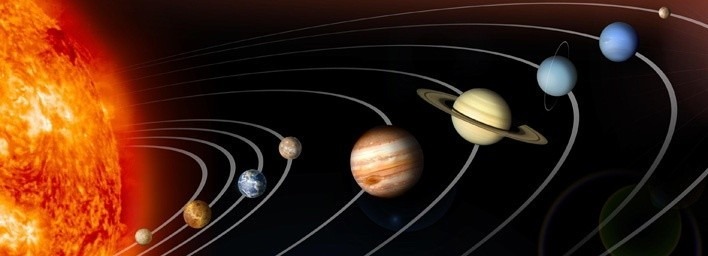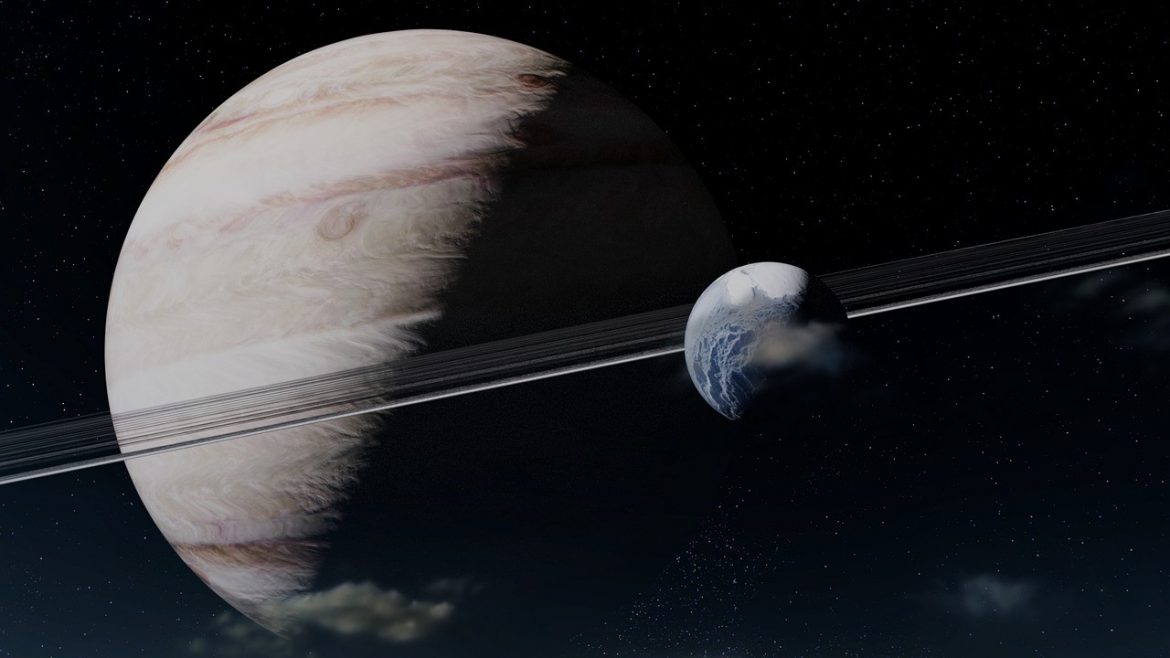The Solar System is vast. We talked about the inner Solar System in the last episode, but that’s only a small part of it. Now, we will talk about the outer Solar System.
Jupiter’s profile
Jupiter is the largest planet in the Solar System, and it is a gas giant. It is huge enough to fit all its neighbouring planets at a diameter of 139,822 kilometres! Also, it is the most massive planet in the Solar System, weighing 317.8 Earths. Although this is about as massive as 2.5 times all the neighbouring planets, it cannot become a star. A star with minimum mass needs to be 75 times the mass of it! If you’re interested, learn more about stars Here.
Jupiter also has the strongest gravitational pull that is 2.5 times that of Earth. Precise calculations of Solar System body’s trajectories must include Jupiter’s gravity. Its barycenter with the Sun lies beyond Sun’s surface, about 1.068 Solar radii from the Sun’s centre although its distance from Sun is 5.2 AU.
Its rotation is the fastest with a period of about 10 hours. But it takes 12 years to orbit Sun once.
In addition, Jupiter has a great red spot larger than Earth’s, and it is a storm that has raged for at least 4 centuries! It has also the most powerful magnetic field, almost approaching the orbit of Saturn! The metallic hydrogen in its interior creates currents, making its magnetosphere. Metallic hydrogen appears because of the high pressure inside Jupiter. Like Saturn, its atmosphere is mostly made of hydrogen and helium.
Jupiter’s moons
Jupiter has the second most moons for one single planet in the Solar System, 79 ones are discovered as of 2020. The majority of their mass is in four Galilean Moons: Io, Europa, Ganymede, Callisto. They are four of six largest moons in the Solar System, with rankings of 4,6,1 and 3 respectively.
Io has volcanoes spewing sulphur (sulfur) so its surface is yellow. Europa has underground oceans that possibly consist of liquid water. Ganymede is the largest moon ever discovered.
Saturn’s dimensions and highlights
Saturn is the second-largest planet in the Solar System, which is 9.14 times the diameter of Earth. It has 95 times the mass of Earth, so it is less dense than water. Saturn’s gravitational force is 1.065 g, not quite different from Earth’s, but there is no surface of it because it is a gas giant.
Its orbital period is 29 years, and its rotational period is a mere 10 hours 40 minutes. Its distance from Sun is 9.5 AU.
Saturn’s rings
Saturn is famous because of its rings. Its rings are no more than 10 metres thick, but it is so bright in a telescope because it is mostly composed of icy debris. Saturn’s rings probably formed when a moon of it reaches Saturn’s Roche limit and it broke the moon apart. Its sequence from Saturn is D-C-B-A-F-G-E, and there is a large gap between the A and B ring called the Cassini Division.
Saturn’s moons
Saturn has the most known moons, which has 82 main ones, and millions of moonlets in its rings but they have never been spotted. 7 moons of it are massive enough to form a circular shape.
The largest moon of Saturn, Titan is the only moon with an atmosphere instead of an exosphere. Moreover, it is even thicker than Earth’s! Also, it has lakes filled with hydrocarbons. Enceladus has organic compounds that were found in plumes blasting from its surface. Iapetus has a strange hue that is black and white.
Uranus’s profile
Uranus is 3.98 times of Earth in diameter, making it the third-largest planet in the Solar System. It also has 14.5 times the mass of Earth. Its gravitational force is only about 90% of Earth, making it weaker than both Venus and Earth.
Its rotational period is 17 hours and 14 days, but it has a weird tilt of 98 degrees, making its spin clockwise. It might be caused by a serious impact that entirely changed the planet. It has an orbital period of 84 years. It’s so long because it is 20 AU from Sun.
Unlike Jupiter and Saturn, Uranus’s atmosphere has methane so it mostly reflects blue light, making its blue hue.
Uranus has 27 moons, which 5 have enough mass to make them circular. They are less than 2,000 kilometres in diameter at most.
Neptune’s profile
Neptune is 3.864 times of Earth in diameter, so it is the fourth-largest planet in the Solar System. It is also the third most massive planet in the system by 17 Earth masses. Its rotational period is about 16 hours and its orbital period is about 165 years, by contrast. That’s because Neptune is 30 AU from Sun.
It is the windiest planet in the Solar System, with supersonic wind speeds of up to 2,100 kilometres per hour! On the other hand, like Uranus, its atmosphere has methane, so it has a blue colour.
Neptune has 13 moons, and the largest one is Triton. Triton is the seventh-largest moon in the Solar System, and it is in retrograde motion. That means it circles Neptune clockwise while Neptune rotates anti-clockwise. Cryovolcanoes are detected on Triton too, which means it is tectonically active.


